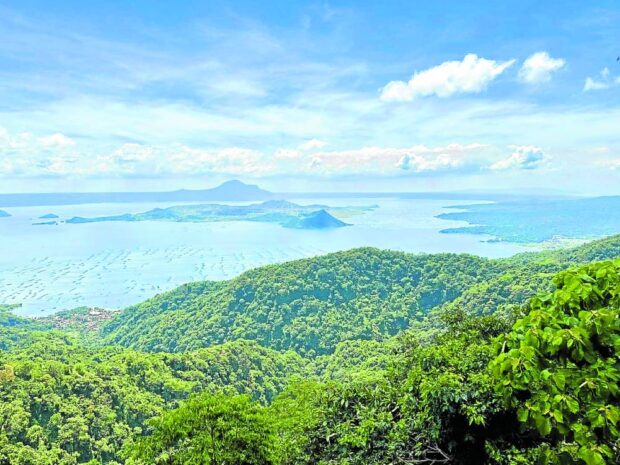Phivolcs logs 3 ‘short-lived’ phreatic eruptions at Taal volcano

FILE PHOTO: Taal Volcano looks serene in this photo taken from Tagaytay City on September 25, 2023. The Office of Civil Defense (OCD) on Saturday, April 20, 2024, reported the occurrence of phreatic eruptions at Taal Volcano. PHOTO FROM THE TAGAYTAY CITY TOURISM OFFICE AND EVELYN GONZALEZ
(UPDATED at 1:10 p.m., April 20, 2024, to reflect the latest information from Phivolcs.)
MANILA, Philippines — The Philippine Institute of Volcanology and Seismology (Phivolcs) on Saturday recorded three “short-lived” phreatic eruptions at Taal Volcano.
According to the state seismologist, their Taal Volcano Network (TVN) logged the first two “phreatic or steam-driven eruption events” from 8:50 a.m. to 9:12 a.m.
“The events lasted more than 2 minutes and produced up to 350 meter-tall steam plumes that drifted West-southwest and Southwest. Alert Level 1 prevails over Taal Volcano,” Phivolcs said on its Facebook page.
The third phreatic eruption was recorded at 11:02 a.m., and lasted for approximately five minutes, producing a 300-meter-tall steam plume that drifted northwest, according to another Phivolcs post on Facebook.
Article continues after this advertisementAll phreatic eruptions were detected at the volcano’s main crater.
Article continues after this advertisementREAD: Taal Volcano blows off steam, but no lava – Phivolcs
Phivolcs said that continued emission of hot volcanic gases at the volcano’s main crater could have triggered the phreatic eruptions. It added that the events “could be succeeded by similar phreatic activity.”
“The background levels of volcanic earthquake activity and ground deformation detected at Taal indicate that unrest is unlikely to progress into magmatic eruption,” Phivolcs, however, said.
It nevertheless “strongly recommends” the strict prohibition of entry into Taal Volcano Island and its Permanent Danger Zone, especially the vicinities of the volcano’s main crater and the Daang Kastila fissure.
“Civil aviation authorities must advise pilots to avoid flying close to the volcano as airborne ash and ballistic fragments from sudden explosions and wind-remobilized ash may pose hazards to aircrafts,” Phivolcs also said.
READ: Taal Volcano back to spewing high-volume of toxic gas
Phivolcs defines phreatic eruptions as “steam-driven explosions that occur when water beneath the ground or on the surface is heated by magma, lava, hot rocks, or new volcanic deposits (for example, tephra and pyroclastic-flow deposits).”
The Office of Civil Defense (OCD) likewise reported about the volcanic event on Saturday morning through its official social media account.
The OCD advised the public that in case of a volcanic eruption, they must:
- When notified, immediately evacuate to safer grounds
- Assist in evacuating children, pregnant women, people with disabilities, and older people
- Cover mouth with wet cloth and wear protective goggles
- Keep pets in shelter or inside so they won’t inhale ash
- Stay away from rivers and streams for possible lahar flow